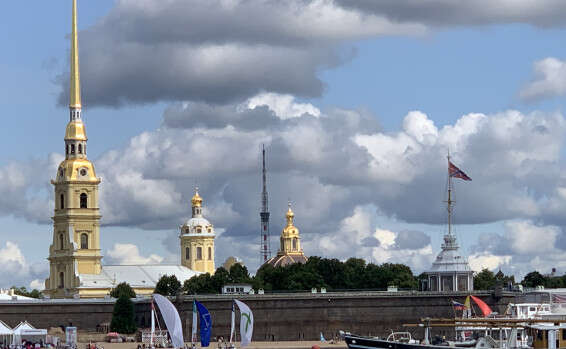For more than 200 years, the Hasidim celebrate the holiday that marks the occasion of the arrest of the Taniya owner • Ya'akov Maor left the fortress where he was imprisoned and returned with impressions
Photo: Jacob Maor
On Chabad Chassidim, Monday, 19 Kislev, marks the "Day of Redemption," commemorating the incident in which Rabbi Shneur Zalman of Ladi, known as the Old Rebbe or the Tana'i, was arrested in 1798, and was held in the St.Proofsplus Fortress in St. Petersburg. 53 days later it was released, and to this day the holiday is marked as one of the main days of the Hasidic.
The cause of the Rebbe's imprisonment was a false and malicious plot by the Hasidic opponents in the town of Lyuzna, where the Rebbe lived, and two-thirds of its inhabitants were Jews. Everyone knew that Rabbi Schneur Zalman financially supported his followers around the world, and also sent funds to Chabad communities in Jerusalem and Safed. At that time, the Ottoman Empire ruled the enemies of the Russian Empire. Opponents of the Hasidism in Luzna and Pinsk informed the authorities that the Rebbe allegedly was transferring money to the Ottoman enemy through Jews in Jerusalem. Such an act is considered a betrayal in Russia, which condemns death.
In fact, what really bothered the informers was that the old Admor became more popular than their rabbis, and some of their children also abandoned their rabbis and their parents' seminary, joining Chabad Hasidim.
When police arrived to take the Rebbe to prison, there was a great deal of surprise and concern that he was being led into a black prison wagon. This black wagon was only intended for very dangerous prisoners. The Taney Rebbe was taken from his home in Luzna to the Petropavalskie Fort, built on an island outside the city of St. Petersburg. The distance to the prison is about 620 km. Today the ride there takes more than 8 hours in the car, but in the 18th century the road took 4-5 days in a horse-drawn carriage.
Chabad Chassidim tell of miracles that happened to the old rabbi on the arduous journey to prison. When the Sabbath came, the Rebbe asked the police to stop the trip until Saturday night. The police officer refused. Then, suddenly, the cart's ax was broken. The repair of the cart continued for a long time. The journey, suddenly one of the horses alive, brought another horse from the nearby town, also harnessed it to the wagon, but the horses refused to go, despite the wagon whistles, so the rabbi and the police remained on the roadside throughout the Sabbath, and only on Saturday night continued the journey to the Petropavloskie Fort.
I went full of curiosity to see the Rebbe's prison. Well, the fort is on an island in the middle of the Nibe River, called "Rabbit Island." The island has six buildings in the form of a hexagon, built of small red bricks. Some of the buildings served as a training and residential base for the secret police.
One of the buildings was built without windows, and served as a prison for rebels suspected of political subversion. There they transferred the Rebbe. This is how it looks from the outside:
The opposite wall of this building also has no windows. At its front are two pillars to which prisoners sentenced to death have been bound, and placed against a firing squad. Rabbi Schneur Zalman was the only prisoner in the place who was saved from this fate.
I wanted to see the cell where the Rebbe was imprisoned, but the entrance inside was not allowed to me, and besides, the webmasters do not know what cell was exactly the Rebbe imprisoned.
On the lawn in the fortress garden there are explanatory signs for the history of the place, including an illustration of what the place looked like in the late 18th century, when the Rebbe was imprisoned there.
Today the fortress serves as a museum for the Bolshevik period, and a museum of St. Petersburg history. The manicured gardens between and outside the buildings have become a public park with restaurants and ice cream shops and food stalls. During the summer season, many St. Petersburg residents come for a stroll.
Some of the Rebbe's interrogations took place inside the jail, and some interrogations took place inside the city of St. Petersburg at the headquarters of the secret police. In the interrogations, the police minister, who was a well-educated gentile and understood a little about Judaism, also intervened personally. He asked the Rebbe various questions and was fascinated by his answers and personality, until he also began to admire the Rebbe. He used to enter the Rebbe's cell for philosophical mental conversations even outside the time of official investigation. The Minister of Police began to work with Russian Tsar Nicholas I to grant Rabbi Pardon. The Czar questioned the impression of the police minister, and wanted to examine for himself what fascinated the minister. The Czar came to prison, changed his office clothes into a simple prison wardrobe, and thus entered the Rebbe's cell. To his surprise, the Rebbe was excited and respected by his majesty. "What's that honor?" Asked the guest, "And that I am the Tsar of Russia?"
"Yes!" The Rebbe replied, explaining to him why he thought so. The Tsar was taken aback.
Entrance gate // Photo: Yaakov Maor
Petropavli Prison is on an island, which now has two bridges connecting it to land. There used to be no bridges, and the traffic to it was only in boats. A Chabad emissary in St. Petersburg, Rabbi Shalom Pevsner, escorted me to the prison, and also took me to see the riverbank pier, from which the boats that had taken the Rebbe for interrogation in the city sailed. The width of the Nibe River in this area seemed to me about a mile. In the Sea of Galilee between Kibbutz Degania and his tent.
While standing by the river, Rabbi Shalom Pevsner tells me another Hasidic legend: One of the wintry nights when the Rebbe returned from the interrogation to his cell in prison, the clouds suddenly dissipated and the moon was scattered. The Rebbe asked to stop to greet 'a white kiddush', but the Russian officer refused. Suddenly the boat's engine was alive. The police tried to restart several times, but were unsuccessful. In the meantime, the Rebbe stood in the boat and said the white kiddush adheringly. When the Rebbe finished, he sat down and signaled to Captain to continue sailing. The seamen tried again to start the boat, and then the engine switched on easily. The cops and seamen realized there was a visible miracle happening. The senior police officer asked the Rebbe to bless him. Since then, the wardens in the fortress have also treated the Rebbe with respect and holy anxiety.
As noted, the investigators became convinced that the Rebbe was innocent, and sent him free 53 days later. The day of liberation was at Bethlehem, exactly 221 years ago. Chabad devotees called it "the day of redemption."
The liberation was not just a personal liberation of the Rebbe but an event in Jewish history. Recognition by the authorities of Hasidic doctrine gave Hasidism and the Torah a public legitimacy. The media exposure of the liberation also caused many Jews in the world to recognize that there is a book of Tanya. As a result, the old Rebbe and his disciples began to spread the Hasidic theory more extensively. No longer in hiding.
Here on Rabbit Island everything began.
On those who celebrate "Feast of Redemption," the old Rebbe said, "Those who rejoice, we will be taken out of the strait into the space." Hasidism, and in the way of Hasidism, you will write and sign. "









